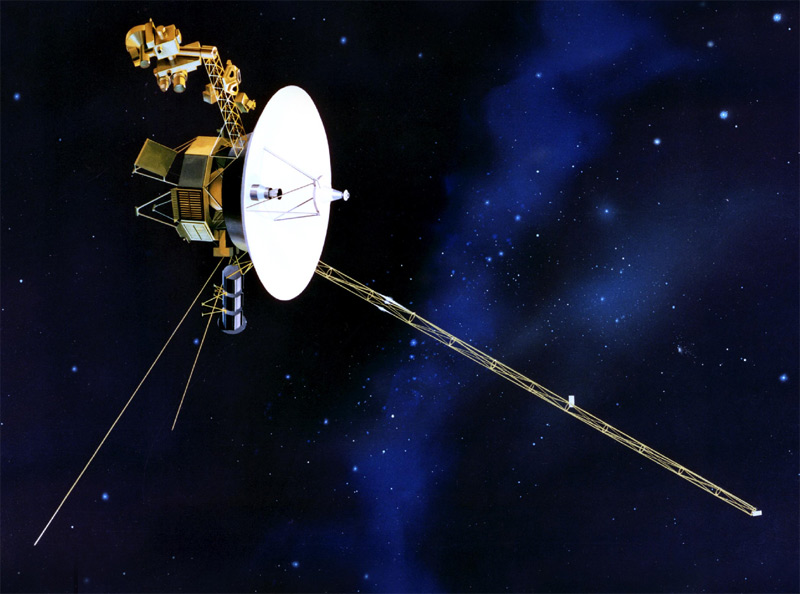NASA Making Voyager Spacecraft Announcement Today: Watch It Live

Editor's Note: The news is out, NASA's Voyager 1 spacecraft has left the solar system and has entered interstellar space. It's Official! Voyager 1 Spacecraft Has Left Solar System
More Voyager News:
- Leaving the Solar System: Q&A with Voyager 1 Chief Scientist Ed Stone
- Voyager 1 Records 'Sounds' From Interstellar Space
- 5 Facts About NASA's Far-Flung Voyager Spacecraft
- Voyager Welcomed To Interstellar Space
- Voyager 1 Goes Interstellar: Solar System Boundary Passed
NASA says it will hold a press conference today (Sept. 12) to discuss an apparently new development with the agency's two far-flung Voyager spacecraft at the edge of the solar system, and you can watch the announcement live online.
The Voyager mission press conference will begin at 2 p.m. EDT (1800 GMT) and be hosted at NASA headquarters in Washington, D.C. You can watch NASA's Voyager announcement live on SPACE.com here, courtesy of NASA TV. The announcement does not indicate if it is about the Voyager 1 mission or Voyager 2 mission, both launched in 1977.
According to NASA's advisory, today's announcement "is related to a paper to be published in the journal Science," and the discovery is embargoed until 2 p.m. EDT. NASA has invited the public to ask questions via Twitter using the agency's #AskNASA hashtag.

NASA has two Voyager spacecaft currently on their way out of the solar system.
NASA's Voyager 1 spacecraft is the farthest manmade object from Earth. The probe launched on Sept. 5, 1977and is currently about 11.6 billion miles (18.7 billion kilometers) from Earth. The spacecraft, like its twin Voyager 2, runs on a nuclear power source, which has allowed it to continue operating for just over 36 years.
Get the Space.com Newsletter
Breaking space news, the latest updates on rocket launches, skywatching events and more!
A long-standing mystery is whether Voyager 1 is still on the edge of the solar system, or actually in interstellar space. For years, Voyager 1 has been traversing a boundary layer of the solar system known as the heliopause as it exits the solar system.
In August, scientists not involved in the Voyager mission published a study suggesting Voyager 1 left the solar system in 2012 in the Astrophysical Journal Letters. But NASA's Voyager 1 mission team and other researchers have said that their data indicated Voyager 1 was still plying through a strange transition zone at the fringe of our solar system.
Voyager 1 and Voyager 2 launched on a so-called "grand tour" of the solar system that ultimately sent the spacecraft on unprecedented flybys of Jupiter, Saturn, Uranus and Neptune.
After completing the "grand tour," the two Voyager probes continued on their separate ways out toward interstellar space. Voyager 2 is currently about 9.4 billion miles (15.2 billion km) from Earth.
Visit SPACE.com today at 2 p.m. EDT (1800 GMT) for complete coverage of today's Voyager 1 spacecraft announcement.
Email Tariq Malik at tmalik@space.com or follow him @tariqjmalik and Google+. Follow us @Spacedotcom, Facebook and Google+. Original article on SPACE.com.
Join our Space Forums to keep talking space on the latest missions, night sky and more! And if you have a news tip, correction or comment, let us know at: community@space.com.

Tariq is the Editor-in-Chief of Space.com and joined the team in 2001, first as an intern and staff writer, and later as an editor. He covers human spaceflight, exploration and space science, as well as skywatching and entertainment. He became Space.com's Managing Editor in 2009 and Editor-in-Chief in 2019. Before joining Space.com, Tariq was a staff reporter for The Los Angeles Times covering education and city beats in La Habra, Fullerton and Huntington Beach. In October 2022, Tariq received the Harry Kolcum Award for excellence in space reporting from the National Space Club Florida Committee. He is also an Eagle Scout (yes, he has the Space Exploration merit badge) and went to Space Camp four times as a kid and a fifth time as an adult. He has journalism degrees from the University of Southern California and New York University. You can find Tariq at Space.com and as the co-host to the This Week In Space podcast with space historian Rod Pyle on the TWiT network. To see his latest project, you can follow Tariq on Twitter @tariqjmalik.










